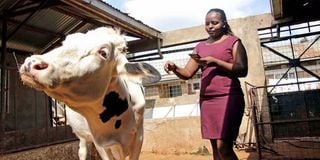Premium
Why you must know the factory that is your dairy cow

A farmer with one of her dairy cows. An animal must be handled in a caring, loving and gentle manner so that it is never scared or distressed.
I have started the New Year with questions from farmers. Despite the difference in formulation, the inquiries converge on one question: “How do you make a cow produce milk to its maximum potential?”
The question is common and I have answered it many times to individual farmers, many of whom find it funny to relate to my description of a dairy cow. I call the animal a factory.
A factory is a place or building where products are made mainly using machines.
But a cow is a biological or live factory where many products are made primarily for sustaining the animal itself and propagating its species.
However, breeding and other scientific interventions have converted the dairy cow into a factory that makes products to improve human food security and livelihoods.
The farmers talking about maximising milk production are interested in increasing their earnings from milk by keeping as few cows as possible and producing large volumes of milk.
Their objective is valid but they need to understand that the modern dairy cow, like a physical factory, requires certain inputs and conditions for it to produce quality goods in the right quantities and at the required time.
Three factory units
The cow can be said to have three main factory units that contribute to optimising milk production.
These are the rumen, udder and the uterus-ovaries. The rumen is the largest of the four stomachs of a cow. It contains billions of micro-organisms of bacterial and protozoal species.
The micro-organisms serve to break down feed material to release the nutrients the cow needs for body function, body maintenance, milk production and reproduction.
Microorganisms also utilise feed nutrients to manufacture nutrients such as proteins and vitamins for their own use.
However, the cow also uses the same nutrients since they are within the rumen fluid environment.
Finally, the cow digests a large volume of the micro-organisms and obtains proteins and some vitamins like those of the B complex.
A cow is able to get a large component of its protein requirements from the micro-organisms in the rumen.
The protein fed to a cow assists the micro-organisms in producing more proteins.
Microorganisms do not produce carbohydrates. Therefore, the dairy cow requires carbohydrates in large quantities.
Uterus function
Thus the inputs required for the proper functioning of the rumen factory unit of the cow are feeds containing high-quality carbohydrates, proteins, vitamins, minerals and water.
This is called a well-balanced diet. The feed quantity should be approximately three to four per cent of the animal’s body weight in kilogrammes on a dry matter basis.
Once the feeds are digested in the rumen and other stomachs, the nutrients are absorbed into the body in the rest of the digestive system.
They are delivered to the factory units through blood and other body fluids.
The udder is the milk manufacturing unit of the cow. It has cells that are controlled by chemicals called hormones.
Most of the hormones are produced by the brain to develop the udder for milk production, sustain milk production, release milk through the teats during milking and to shut down milk production during pregnancy or when milk production cannot be sustained due to disease or lack of nutrients.
Farmers should pay attention to udder development from the time the calf is conceived to the time the heifer gets its maiden calving to ensure the cow realises its milk production potential.
This is done through proper feeding of the pregnant cow and the calf through to puberty and the first pregnancy.
Heifer calves that get stunted due to poor feeding have under-developed udders and never realise their milk production potential.
The uterus and ovaries factory unit provides the cow with reproduction services that ensure the propagation of the species.
It provides the farmer with more calves that grow into cows for milk production or bulls to provide semen to produce more calves.
The uterus function is also mainly controlled by hormones released by the brain.
The combined outcomes of the functions of the three dairy cow factory units ensure the cow produces maximum quantities of milk, depending on the animal’s genetic makeup.
Failure in the function of one unit affects milk output.
Genetic make-up
The genetic make-up may be considered to be the factory design of the cow.
Friesian cattle are generally known to be, on average, the highest milk producers in the world.
Finally, for the cow to give the maximum production of milk, it must be provided with conditions that minimise stress. It must be kept free of pain, injuries or diseases.
Its environment should be clean and comfortable. The animal must also be handled in a caring, loving an gentle manner so that it is never scared or distressed.
The environment should enable the cow to express its normal behaviour such as grooming and cuddling with others.
When environmental conditions are adverse to dairy cattle, the animal produces bodily chemicals like adrenaline and cortisol that depress milk production.
Prolonged or frequent production of the chemicals also causes lowered immunity that exposes the animal to diseases, defective utilisation of nutrients and body wastage.





